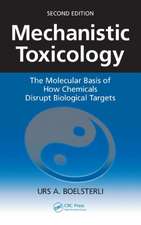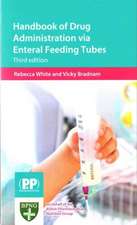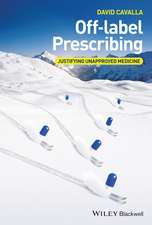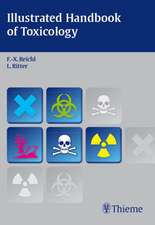Toxicity Assessment Alternatives: Methods, Issues, Opportunities
Editat de Harry Salem, Sidney A. Katzen Limba Engleză Hardback – 2 iul 1999
| Toate formatele și edițiile | Preț | Express |
|---|---|---|
| Paperback (1) | 1092.58 lei 6-8 săpt. | |
| Humana Press Inc. – 26 mar 2013 | 1092.58 lei 6-8 săpt. | |
| Hardback (1) | 1100.64 lei 6-8 săpt. | |
| Humana Press Inc. – 2 iul 1999 | 1100.64 lei 6-8 săpt. |
Preț: 1100.64 lei
Preț vechi: 1158.57 lei
-5% Nou
Puncte Express: 1651
Preț estimativ în valută:
210.67€ • 228.92$ • 177.08£
210.67€ • 228.92$ • 177.08£
Carte tipărită la comandă
Livrare economică 21 aprilie-05 mai
Preluare comenzi: 021 569.72.76
Specificații
ISBN-13: 9780896037878
ISBN-10: 0896037878
Pagini: 262
Ilustrații: XIII, 262 p. 24 illus.
Dimensiuni: 148 x 221 x 25 mm
Greutate: 0.58 kg
Ediția:1999
Editura: Humana Press Inc.
Colecția Humana
Locul publicării:Totowa, NJ, United States
ISBN-10: 0896037878
Pagini: 262
Ilustrații: XIII, 262 p. 24 illus.
Dimensiuni: 148 x 221 x 25 mm
Greutate: 0.58 kg
Ediția:1999
Editura: Humana Press Inc.
Colecția Humana
Locul publicării:Totowa, NJ, United States
Public țintă
ResearchCuprins
I. Recent Developments on Alternatives.- 1 Tissue Engineering: An Important Technology for Assessment of Toxicity.- 2 Tissue Engineering: Technology Applications and FDA Initiatives.- 3 Electrical Resistance Method for Measuring Volume Changes in Astrocytes.- 4 Cytotoxicity Profiles for a Series of Investigational Compounds Using Liver Slice Technology and Human-Derived Cell Cultures.- 5 Antagonistic Interaction of Sodium Arsenite and Lead Sulfate with UV Light on Sister Chromatid Exchanges in Human Peripheral Lymphocytes.- 6 The Role of Upper Airway Heat and Water Vapor Exchange in Hygroscopic Aerosol Deposition in the Human Airway: A Deposition Model.- 7 Moving Average Interpolation for Malathion LC50 Estimation on Dugesia tigrina: Comparison with Probit and “One-Point” Methods.- 8 Physiological Modeling of Benzo(a)pyrene Pharmacokinetics in the Rat.- II. Current Trends and Future Directions.- 9 Resources for Biomedical Research: Opportunities for Alternatives.- III. Mechanistically Based Test Methods as Alternatives.- 10 Endocrine Disruption in Wildlife: Scientific Processes and Principles for Evaluating Effects.- 11 Mechanistic Animal-Replacement Approaches for Predicting Pharmacokinetics of Organic Chemicals.- IV. Use of Alternatives in Hazard Assessment Initiatives.- 12 Validation of the CytosensorTM Microphysiometer for In Vitro Cytotoxicity Testing.- 13 Sulfur Mustard Effects on Cell Yield Alter Viability Assessment in Normal Human Epidermal Keratinocytes.- 14 Development of Human Keratinocyte Colonies for Confocal Microscopy and for Study of Calcium Effects on Growth Differentiation and Sulfur Mustard Lesions: A Model.- 15 Phosgene-Induced Calcium Changes in Pulmonary Artery Endothelial Cells.- 16 Enhanced Proteolytic Activity and Fc Receptor Expression inHuman Epithelial Cells Following Exposure to Sulfur Mustard.- 17 Altered Expression of lntracellular and Surface Antigens by Cultured Human Epidermal Keratinocytes Exposed to Sulfur Mustard.- 18 Effect of Sulfur Mustard Exposure on Human Epidermal Keratinocyte Viability and Protein Content.- 19 The Use of In Vitro Systems to Define Therapeutic Approaches to Cutaneous Injury by Sulfur Mustard.- 20 Effects of Poly (ADP-Ribose) Polymerase Inhibitors on the Sulfur Mustard-Induced Disruption of the Higher-Order Nuclear Structure of Human Lymphocytes.- 21 DNA Repair Enzymatic Response in Cultured Human Epidermal Keratinocytes Following Sulfur Mustard Exposure.- 22 Human Hepatocytes: A Novel Animal Alternative.- V. Validation, Regulatory Acceptance, and Animal Protection Perspectives.- 23 An Animal Protection Perspective.- 24 Federal Interagency Activities Toward Validation and Regulatory Acceptance of Alternative Tests.
Recenzii
"The value of these methods is that they can provide alternatives to more expensive and politically sensitive animal testing methods. . .By focusing on the human keratinocyte cell system, the complex response to sulfur mustard provides an excellent case example of the value of these alternative methods, and in this, this book is unique in the field. "-Doody's Health Sciences Book Review Journal
"This book is an up-to-date description of what has been accomplished thus far in developing acceptable alternatives to classical animal toxicity assessment methods. It includes not only reviews about alternatives for animal testing as such (e.g., tissue cultures for dermal toxicity and endocrine disruptor assessment, in vitro protein denaturation to assess ocular and dermal irritation potential of chemicals, and validation of alternative tests), it also reports on increasing testing efficiency (e.g., trans-genic models that reduce time and cost of carcinogenicity testing), and it presents tools for a better understanding of the toxic process (e.g., molecular modeling to explain chemical toxicity)....it presents a handsome and conveniently arranged overview of the topics and perspectives regarding the state-of-the-art of alternative toxicity testing."-EUROTOX European Societies of Toxicology
"This book is an up-to-date description of what has been accomplished thus far in developing acceptable alternatives to classical animal toxicity assessment methods. It includes not only reviews about alternatives for animal testing as such (e.g., tissue cultures for dermal toxicity and endocrine disruptor assessment, in vitro protein denaturation to assess ocular and dermal irritation potential of chemicals, and validation of alternative tests), it also reports on increasing testing efficiency (e.g., trans-genic models that reduce time and cost of carcinogenicity testing), and it presents tools for a better understanding of the toxic process (e.g., molecular modeling to explain chemical toxicity)....it presents a handsome and conveniently arranged overview of the topics and perspectives regarding the state-of-the-art of alternative toxicity testing."-EUROTOX European Societies of Toxicology
Textul de pe ultima copertă
In Toxicity Assessment Alternatives, internationally known scientists review what has been accomplished thus far in developing acceptable alternatives to classical animal toxicity assessment methods. Authoritative chapters describe not only the many practical alternative approaches that have recently emerged, but also consider current trends and likely future approaches, as well as emerging automated assessment techniques. Hazard assessment applications and the validation of new alternative methods are also discussed. The methods described here will help toxicologists, cosmetic chemists, and pharmacologists greatly reduce, refine, or even possibly replace, the use of laboratory animals in their work. Life science researchers will also find many new opportunities for detecting endocrine disruptions. Regulatory officers will gain a new perspective on alternative assessment, environmental assessment, and risk assessment.
Significantly extending the efforts the National Institutes of Health, the European Union, and the ICCVAM, Toxicity Assessment Alternatives offers all those evaluating toxicity today a cutting-edge collection of practical and highly effective alternative methods.
Significantly extending the efforts the National Institutes of Health, the European Union, and the ICCVAM, Toxicity Assessment Alternatives offers all those evaluating toxicity today a cutting-edge collection of practical and highly effective alternative methods.








